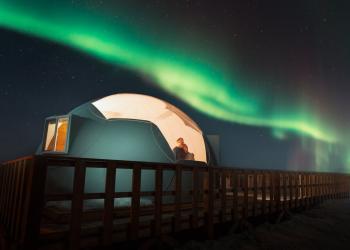Image Caption
Local Journalism Initiative Reporter
Windspeaker.com
Indigenous tourism in Canada is a growing attraction, said federal Tourism Minister Randy Boissonnault, with at least one-third of international travelers and one-third of Canadian travelers wanting the “Indigenous authentic experience.”
Despite those statistics, there were no dedicated dollars in last month’s federal budget for Indigenous tourism in the $158 million set aside for the tourism sector.
And there is little chance that one-third of the $108 million in the soon-to-be announced Federal Tourism Growth Strategy (FTGS) will be earmarked for Indigenous tourism businesses.
“I think where we get into the numbers, a third of the people who come to Canada want that experience. Are they able to get it? Not yet,” said Boissonnault in an exclusive interview with Windspeaker.com.
Boissonnault committed to directing a minimum of 10 per cent of FTGS’s budget to Indigenous tourism businesses.
The FTGS is supposed to “chart a course for growth, investment and stability in Canada’s tourism sector,” he said.
Meetings were held with tourism operators starting in May 2022, including bilateral meetings with the Indigenous Tourism Association of Canada (ITAC), to set priorities for the FTGS.
Boissonnault is hoping to announce the strategy in late spring.
Ten per cent is also the figure that the Indigenous tourism sector received through the $500 million Tourism Relief Fund, which was put in place to help tourism businesses in post-pandemic economic recovery. Applications for the relief fund have just closed.
Earlier this week, the Métis Crossing, a cultural destination near Smoky Lake, Alta., received $1.45 million through the relief fund to support its Sky Watching Domes. The domes are the latest addition to a portfolio of accommodation options designed to meet a range of interests and price points.
Before the pandemic struck, said Boissonnault, Indigenous tourism was the fastest growing subsector at $1.9 billion in revenues in 2019.
One of the challenges in supporting Indigenous tourism operations, he said, is that 80 to 85 per cent are sole proprietors with one or two employees and are “on our books through the Canada Revenue Agency but not through Innovation, Science and Economic Development (ISED) Canada.”
Boissonnault is the first stand-alone federal tourism minister. However, tourism is one of 18 departments and agencies to comprise the ISED portfolio. Boissonnault also serves as associate finance minister.
“It’s harder for us as a government to work with sole proprietors,” he said.
To that end, funding from FTGS will be meted out to regional development agencies and they may decide to give more than 10 per cent to Indigenous operators, said Boissonnault. Funding will also go to Indigenous tourism associations, but not every province or territory has an association.
“For me it’s about making sure that business operators, whether they’re sole proprietors or they’re incorporated businesses, have access to that funding,” he said.
The 2023-24 budget also includes $50 million over three years for Destination Canada, in order to attract major international conventions, conferences and events. That has the potential for a “spill-off effect” for Indigenous tourism operators, said Boissonnault.
In an interview earlier this month with Windspeaker.com, Keith Henry, CEO of ITAC, expressed disappointment with the lack of dedicated funding for Indigenous tourism.
“There’s never a guarantee in any budget cycle. This was an extremely lean budget cycle,” said Boissonnault.
“We pushed as hard as we can inside the budget process. In this particular budget process, I’m very pleased with the fact that we got $158 million for tourism and, absolutely, Indigenous operators are going to see benefits from that $158 million.”
On top of that money, said Boissonnault, the 2022 budget has $20 million for Indigenous tourism that has yet to roll out.
“As soon as I get through the process of finalizing the Federal Tourism Growth Strategy and we get through Treasury Board, that money will be out into the ecosystem for Indigenous tourism operators,” he said.
Boissonnault also pointed out that the “budget isn’t a menu list for all the things the government is going to do.”
He noted that dollars will be available for Indigenous tourism operators through base funding in other programs and through other ministries.
Prairies Development Canada, for example, has a base budget that is accessible to Indigenous tourism operators if they apply with a “good proposal,” he said.
Prairies Development Canada also falls under the ISED portfolio.
Boissonnault said that Indigenous tourism operators needed to “put their own capital on the table” in order to develop their vision, to attract partners to help build assets, and to attract tourists to Canada.
“I want to see Indigenous iconic attractions built across this country and I want to do that in partnership with the whole ecosystem, including ITAC and the provincial partners,” he said.
Never miss a Windspeaker article. Subscribe Today to our new Windspeaker Newsletter!
Local Journalism Initiative Reporters are supported by a financial contribution made by the Government of Canada.

